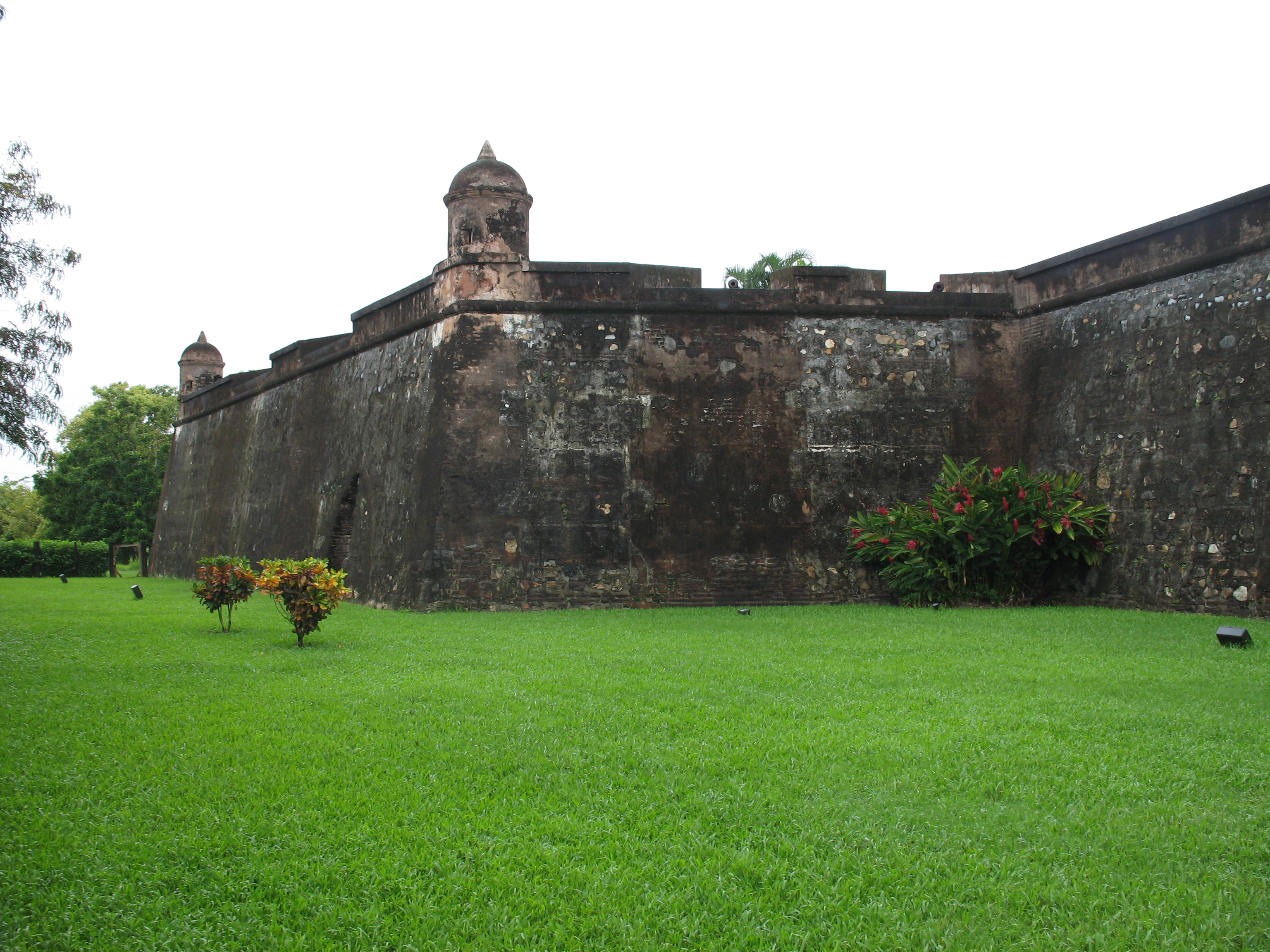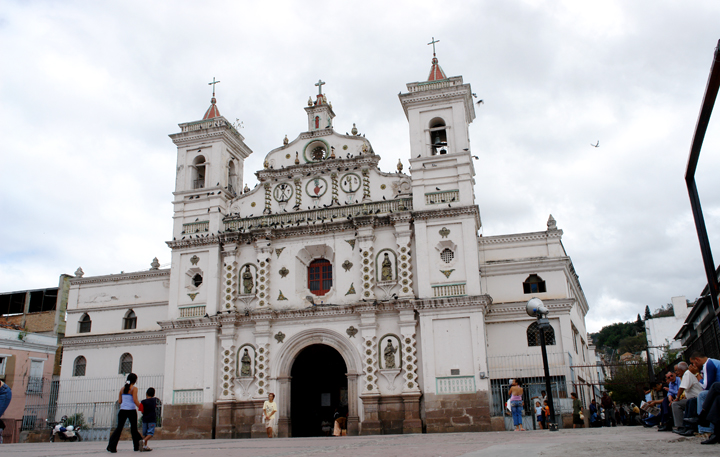|
Omoa, Cortés
Omoa is a town, with a population of 7,020 (2013 census), and a municipality in the Department of Cortés in Honduras. Omoa is located on a small bay of the same name 18 km west of Puerto Cortés on the Caribbean Sea coast. Geography Omoa is both a municipality and a small town located along the Northwest Caribbean coast of Honduras. It is populated by about 30,000 people distributed within an area of 382.8 km². History In 1536 Omoa was a small "pueblo de indios" allocated in repartimiento by Pedro de Alvarado to Luis del Puerto along with the nearby Indian town of Chachaguala. But by 1582 Omoa had ceased to exist as a viable community. Repeated pirate raids on coastal towns along the Caribbean coast of Central America led the Spanish Crown as early as 1590 to begin looking for a new defensible port for the Captaincy General of Guatemala to export its goods to Spain. This initial study by Antonelli, and many subsequent ones, all pointed to the bay at Omoa as t ... [...More Info...] [...Related Items...] OR: [Wikipedia] [Google] [Baidu] |
Fatu Hiva
Fatu-Hiva (the "H" is not pronounced, see name section below) is the southernmost island of the Marquesas Islands in French Polynesia, an overseas territory of France in the Pacific Ocean. With Motu Nao as its closest neighbor, it is also the most isolated of the inhabited islands. ''Fatu Hiva'' is also the title of a book by explorer and archaeologist Thor Heyerdahl, in which he describes his stay on the island in the 1930s. Name The name of the island in Marquesan is Fatu Iva (without "h": ). However, the name was recorded by Europeans as ''Fatu-Hiva,'' perhaps under the influence of other Marquesan islands containing the element ''Hiva'' ( Nuku-Hiva and Hiva-Oa) and also because in French the letter "h" is silent. The spelling ''Fatu-Hiva'' has now become official. The island was named ''Isla Magdalena'' ("Magdalene Island") by Spanish explorers in the 16th century, a name rarely used. Hatauheva is another name form that appears in 1817, by Camille de Roquefeuil during h ... [...More Info...] [...Related Items...] OR: [Wikipedia] [Google] [Baidu] |
Tegucigalpa
Tegucigalpa (, , ), formally Tegucigalpa, Municipality of the Central District ( es, Tegucigalpa, Municipio del Distrito Central or ''Tegucigalpa, M.D.C.''), and colloquially referred to as ''Tegus'' or ''Teguz'', is the capital and largest city of Honduras along with its sister city, Comayagüela. Claimed on 29 September 1578 by the Spaniards, Tegucigalpa became the country's capital on October 30, 1880, under President Marco Aurelio Soto, when he moved the capital from Comayagua. The Constitution of Honduras, enacted in 1982, names the sister cities of Tegucigalpa and Comayagüela as a Central District to serve as the permanent national capital, under articles 8 and 295. After the dissolution of the Federal Republic of Central America in 1841, Honduras became an individual sovereign nation with Comayagua as its capital. The capital was moved to Tegucigalpa in 1880. On January 30, 1937, Article 179 of the 1936 Honduran Constitution was changed under Decree 53 to establish Te ... [...More Info...] [...Related Items...] OR: [Wikipedia] [Google] [Baidu] |
Populated Places Established In 1752
Population typically refers to the number of people in a single area, whether it be a city or town, region, country, continent, or the world. Governments typically quantify the size of the resident population within their jurisdiction using a census, a process of collecting, analysing, compiling, and publishing data regarding a population. Perspectives of various disciplines Social sciences In sociology and population geography, population refers to a group of human beings with some predefined criterion in common, such as location, race, ethnicity, nationality, or religion. Demography is a social science which entails the statistical study of populations. Ecology In ecology, a population is a group of organisms of the same species who inhabit the same particular geographical area and are capable of interbreeding. The area of a sexual population is the area where inter-breeding is possible between any pair within the area and more probable than cross-breeding with ind ... [...More Info...] [...Related Items...] OR: [Wikipedia] [Google] [Baidu] |
Spanish Colonial Fortifications In Honduras
Spanish might refer to: * Items from or related to Spain: **Spaniards are a nation and ethnic group indigenous to Spain **Spanish language, spoken in Spain and many Latin American countries **Spanish cuisine Other places * Spanish, Ontario, Canada * Spanish River (other), the name of several rivers * Spanish Town, Jamaica Other uses * John J. Spanish (1922–2019), American politician * "Spanish" (song), a single by Craig David, 2003 See also * * * Español (other) * Spain (other) * España (other) * Espanola (other) * Hispania, the Roman and Greek name for the Iberian Peninsula * Hispanic, the people, nations, and cultures that have a historical link to Spain * Hispanic (other) * Hispanism * Spain (other) * National and regional identity in Spain * Culture of Spain * Spanish Fort (other) Spanish Fort or Old Spanish Fort may refer to: United States * Spanish Fort, Alabama, a city * Spanish Fo ... [...More Info...] [...Related Items...] OR: [Wikipedia] [Google] [Baidu] |
Municipalities Of The Cortés Department
A municipality is usually a single administrative division having corporate status and powers of self-government or jurisdiction as granted by national and regional laws to which it is subordinate. The term ''municipality'' may also mean the governing body of a given municipality. A municipality is a general-purpose administrative subdivision, as opposed to a special-purpose district. The term is derived from French and Latin . The English word ''municipality'' derives from the Latin social contract (derived from a word meaning "duty holders"), referring to the Latin communities that supplied Rome with troops in exchange for their own incorporation into the Roman state (granting Roman citizenship to the inhabitants) while permitting the communities to retain their own local governments (a limited autonomy). A municipality can be any political jurisdiction, from a sovereign state such as the Principality of Monaco, to a small village such as West Hampton Dunes, New York. The ... [...More Info...] [...Related Items...] OR: [Wikipedia] [Google] [Baidu] |
Hurricane Fifi–Orlene
Hurricane Fifi, later known as Hurricane Orlene, was a catastrophic tropical cyclone that killed over 8,000 people in Honduras in September 1974, ranking it as the third deadliest Atlantic hurricane on record, only behind Hurricane Mitch in 1998, and the 1780 hurricane. Fifi is also the first billion-dollar hurricane not to make landfall in the U.S. Originating from a strong tropical wave on September 14, the system steadily tracked west-northwestward through the eastern Caribbean. On September 16, the depression intensified into Tropical Storm Fifi just off the coast of Jamaica. The storm quickly intensified into a hurricane the following afternoon and attained its peak intensity on September 18 as a strong Category 2 hurricane. Maintaining hurricane intensity, Fifi brushed the northern coast of Honduras before making landfall in Belize the following day. The storm quickly weakened after landfall, becoming a depression late on September 20. Continuing west ... [...More Info...] [...Related Items...] OR: [Wikipedia] [Google] [Baidu] |
Juan Galindo
Juan Galindo (1802 – 30 January 1840) was an Anglo-Irish political activist and military and administrative officer under the Liberal government of the Federal Republic of Central America. He represented the government in a diplomatic mission to the United States and England. His duties in Central America allowed him to explore the region and examine Maya ruins. The reports on his findings earned him recognition as an early pioneer of Maya archaeology. Early Years Galindo was born in Dublin in 1802 as John Galindo. His father, Philemon Galindo was an Englishman of Spanish descent and his mother, Catherine Gough, was Irish.Drew 1999, p. 51. Both parents were actors who met while working at a theater in Bath. They married in Dublin in 1801. His early life is obscure and it is not known why or exactly when he left for the New World. Sources differ on his emigration but sometime before he was twenty he either joined Admiral Thomas Cochrane to fight for Chile's independence or he ... [...More Info...] [...Related Items...] OR: [Wikipedia] [Google] [Baidu] |
Royal Irish Regiment (1684–1922)
The Royal Irish Regiment, until 1881 the 18th Regiment of Foot, was an infantry regiment of the line in the British Army, first raised in 1684. Also known as the 18th (Royal Irish) Regiment of Foot and the 18th (The Royal Irish) Regiment of Foot, it was one of eight Irish regiments raised largely in Ireland, its home depot in Clonmel. It saw service for two and a half centuries before being disbanded with the Partition of Ireland following establishment of the independent Irish Free State in 1922 when the five regiments that had their traditional recruiting grounds in the counties of the new state were disbanded. History Formation to end 19th century The regiment was formed in 1684 by the Earl of Granard from independent companies in Ireland. As Hamilton's Foot, it served in Flanders during the Nine Years War and at Namur on 31 August 1695, took part in the capture of the Terra Nova earthwork, later commemorated in the song 'The British Grenadiers.' In recognition, of this, Will ... [...More Info...] [...Related Items...] OR: [Wikipedia] [Google] [Baidu] |
Royal Navy
The Royal Navy (RN) is the United Kingdom's naval warfare force. Although warships were used by English and Scottish kings from the early medieval period, the first major maritime engagements were fought in the Hundred Years' War against France. The modern Royal Navy traces its origins to the early 16th century; the oldest of the UK's armed services, it is consequently known as the Senior Service. From the middle decades of the 17th century, and through the 18th century, the Royal Navy vied with the Dutch Navy and later with the French Navy for maritime supremacy. From the mid 18th century, it was the world's most powerful navy until the Second World War. The Royal Navy played a key part in establishing and defending the British Empire, and four Imperial fortress colonies and a string of imperial bases and coaling stations secured the Royal Navy's ability to assert naval superiority globally. Owing to this historical prominence, it is common, even among non-Britons, to ref ... [...More Info...] [...Related Items...] OR: [Wikipedia] [Google] [Baidu] |
Exterior Fuerte De Omoa Honduras
In mathematics, specifically in topology, the interior of a subset of a topological space is the union of all subsets of that are open in . A point that is in the interior of is an interior point of . The interior of is the complement of the closure of the complement of . In this sense interior and closure are dual notions. The exterior of a set is the complement of the closure of ; it consists of the points that are in neither the set nor its boundary. The interior, boundary, and exterior of a subset together partition the whole space into three blocks (or fewer when one or more of these is empty). Definitions Interior point If is a subset of a Euclidean space, then is an interior point of if there exists an open ball centered at which is completely contained in . (This is illustrated in the introductory section to this article.) This definition generalizes to any subset of a metric space with metric : is an interior point of if there exists r > 0, such that ... [...More Info...] [...Related Items...] OR: [Wikipedia] [Google] [Baidu] |





